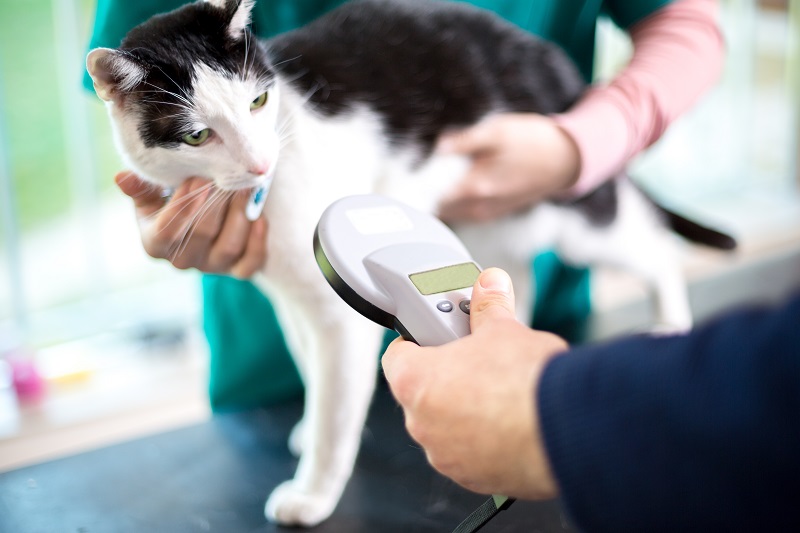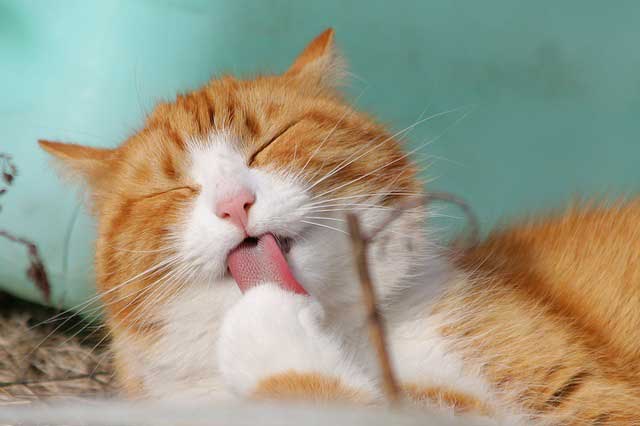Flea and Tick Prevention 101
Flea and Tick Prevention 101
 Fleas and ticks are one of the last things most of us want to think about, but these creepy-crawlies can pose some serious health risks to your pets. They’re more than just annoying—as it turns out, fleas, ticks, and the diseases they carry can be passed to the human members of the family as well.
Fleas and ticks are one of the last things most of us want to think about, but these creepy-crawlies can pose some serious health risks to your pets. They’re more than just annoying—as it turns out, fleas, ticks, and the diseases they carry can be passed to the human members of the family as well.
Year-round flea and tick prevention is an important part of pet health and wellness care. Your partners in pet care at The Bluffs Pet Clinic are here to help you every step of the way as you learn about protecting your pets and family from fleas and ticks.
Fleas
While fleas are found in many places, one of the most likely sources in our area is rabbits. If you have rabbits in your yard or anywhere that your pet frequents, then they are at risk. One female flea can lay up to 50 eggs per day, which can quickly lead to a full scale infestation. Fleas are easily passed from one pet to another, to household furnishings, and even to people.
Although we associate fleas with annoying itching, they can also cause some serious health concerns for pets and people. Some pets are severely allergic to flea saliva, resulting in an allergic skin reaction called dermatitis. Dermatitis causes severe itching and can lead to hot spots and skin infections.
In addition to dermatitis, fleas can also transmit tapeworm and certain bacterial diseases such as Bartonellosis (cat scratch fever) to both pets and humans. If the infestation is severe enough, it can also lead to anemia in your pet.
Ticks
Unlike fleas, ticks are not insects, but rather more closely related to spiders. Ticks tend to hide in grass and shrubs, waiting for a warm-blooded host to wander by. Ticks burrow their heads into their host animal’s skin and feed on the plentiful blood supply.
Ticks pose a much greater health risk to pets and humans because they are more likely to transmit serious diseases including Rocky Mountain spotted fever, Lyme disease, and tick borne encephalitis.
Year-Round Flea and Tick Prevention
Contrary to popular belief, flea and tick prevention is not a seasonal affair. Even here in Minnesota where the winters seem like they’ll never end, fleas and ticks can still affect our pets. In the winter, ticks hibernate in the trees and will come out as soon as the snow melts around the base of the trees. The warm, dry environments of our homes are the perfect climate for small critters like fleas and ticks to thrive. The constant influx of pets and people who travel from other climates causes a constant influx of external parasites, as well.
As with most health issues, prevention is always preferable to treating the effects of a flea infestation or tick bite. Fortunately, there are a variety of products on the market that provide pets with year-round protection. If your pet hasn’t yet started on a monthly flea and tick prevention regimen, please give us a call for more information.
Other Ways to Protect Your Pet
Along with preventive treatment, there are plenty of other ways you can help to keep your pets safe from external parasites:
- Fleas and ticks often make their homes in tall grasses and weeds. Cutout their available habitat by keeping your yard trimmed and free of weeds and debris.
- Inspect your pet from head to toe after he or she has been outside, and remove any ticks immediately.
- Bathe and groom your pet on a regular basis.
- Be sure to wash your pet’s bedding in hot water weekly, as it can be a breeding ground for bacteria, fungus, and parasites.
Your veterinarian should be your first line of defense against pet parasites. Please contact us with any questions or for more information. We are more than happy to address your questions and concerns regarding flea and tick prevention.
The Importance of Heartworm Protection for Pets
 Most pet owners have heard of heartworm, but few of us understand what it is and the danger it poses to our pets. In colder climates, such as here in Minnesota, heartworm just doesn’t seem like a big risk, causing many pet parents to put year-round parasite prevention on the back burner.
Most pet owners have heard of heartworm, but few of us understand what it is and the danger it poses to our pets. In colder climates, such as here in Minnesota, heartworm just doesn’t seem like a big risk, causing many pet parents to put year-round parasite prevention on the back burner.
April is Heartworm Awareness Month, and the team at The Bluff’s Pet Clinic would like to take this opportunity to share with our readers the importance of heartworm protection for all pets.
Getting to Know Heartworm
Heartworm is present in all 48 contiguous states and Hawaii, as well as throughout the temperate regions of the world, and poses a serious risk to canine and feline health.
Heartworm is caused by the parasitic worm Dirofilaria immitis, and is transmitted by mosquitoes that have fed on an infected animal, such as a dog, cat, coyote, raccoon, opossum, or wolf. The worms take up residence in the heart, lungs, and accompanying blood vessels, wreaking havoc on the internal organs as they grow and reproduce over a period of several months or years.
Heartworm in dogs can be treated if caught early enough, but treatment is expensive and painful, and often requires months of confinement.
A Word About Cats
Cats are considered an atypical host for heartworm, meaning they’re not as physiologically compatible with the disease as dogs. This is why there are fewer cases of heartworm in cats, but it’s also the why there is no effective treatment for feline heartworm. It only takes a few worms for the disease to be fatal.
Signs and Symptoms
Symptoms commonly associated with heartworm disease include:
- Coughing or asthma-like symptoms
- Labored breathing
- Vomiting
- Fatigue
- Lack of interest in play or exercise
- Weight loss
Heartworm Protection for Dogs and Cats
It wasn’t that long ago that preventing heartworm in pets was expensive and time consuming. Today, heartworm protection is as simple as a monthly preventive medicine, and is all that is required to keep your dog or cat disease-free. Most heartworm preventives also include medications designed to kill common intestinal parasites, giving you even more reason to keep your pet on the preventive all year long.
If you haven’t started your dog or cat on a monthly heartworm preventive medication, or are in need of a refill, please contact the staff at The Bluffs Pet Clinic today!
Pet Microchips—So Much More Than Pet ID!

Are You Having a Pet Emergency? How to Know When It Can’t Wait
 While it may not seem like rocket science to figure out what is an emergency and what isn’t, oftentimes things are not clear cut.
While it may not seem like rocket science to figure out what is an emergency and what isn’t, oftentimes things are not clear cut.
Next time you are wondering after hours if your pet’s problem can wait until the morning, take a look at our pet emergency reference guide to help decide if you need to seek immediate care.
Recognizing a Pet Emergency
All pet owners should know the deal breakers – those symptoms or situations that fall into the “do not pass go, do not collect $200” category. If your pet is exhibiting any of these symptoms or is affected by any of these conditions, urgent care is essential. Seek emergency care if your pet:
- Has suffered trauma, such as being hit by a car, even if he or she seems fine
- Has bleeding that does not stop within a few minutes
- Has been (or potentially has been) exposed to a toxic substance
- Has eaten a non-digestible object
- Displays symptoms of pain
- Is straining to or cannot urinate
- Is bleeding from an orifice
- Collapses
- Is having trouble with one or both eyes
- Has a seizure
- Appears to have a swollen abdomen
- Has vomiting or diarrhea that occurs more than once
- May have a broken bone
- Is having difficulty breathing
- Is in active labor and has not had a puppy or kitten in 2 hours
By paying close attention to your four-legged family member, you can make yourself familiar with what his or her normal habits are. If your pet isn’t eating or drinking normally, is acting strangely, starts limping, or displays other unusual behavior, it is never wrong to have things checked out. You know your pet best, and if you feel something is wrong, it probably is.
How to Handle a Pet Emergency
If your pet is having some level of emergency, it can certainly be a little scary. Try to take a deep breath and call us right away. We may be able to coach you through stabilizing your pet, or help you determine the level of emergency. For true emergencies, we always appreciate a call to know that you are on the way, so that we can be prepared to help more quickly.
If it occurs outside of our normal business hours, please don’t hesitate to call one of the many wonderful emergency hospitals in the area. They work together with us to bring your family the best veterinary care possible.
It can help to educate yourself a little about pet emergencies in advance of a problem. Make an effort to review some pet emergency care tips. A pet first aid kit can also be handy to have available.
Pets are very good at hiding symptoms of a problem until things become quite serious. This is why it is so important not to wait too long to seek help. Never hesitate to call us at The Bluffs Pet Clinic if you think that there might be a problem. We are always happy to help.
The Weather is Frightful, So is the Food: Preventing a Pet Poisoning This Holiday Season
 The holidays are all about families celebrating together. Tables overflowing with savory, decadent food, champagne glasses clinking, and abundant greenery adorning every surface and walkway. All of this sounds lovely, but when you add your pet to the mix, your sparkling holiday scene could turn into a disaster rather quickly. While there’s definitely room for concern, pet poisoning around the holidays can be prevented when you learn to recognize the common culprits.
The holidays are all about families celebrating together. Tables overflowing with savory, decadent food, champagne glasses clinking, and abundant greenery adorning every surface and walkway. All of this sounds lovely, but when you add your pet to the mix, your sparkling holiday scene could turn into a disaster rather quickly. While there’s definitely room for concern, pet poisoning around the holidays can be prevented when you learn to recognize the common culprits.
Chocolate
From advent calendars to Hanukkah gelt, chocolate is ubiquitous during the holidays. It’s given as gifts, it’s a showpiece on the dessert buffet, and it even makes an appearance in cocktails.
Depending on the amount and type of chocolate consumed, theobromine is responsible for hyperactivity, vomiting, diarrhea, muscle tremors, seizures, or even heart attack in pets.
Keep all chocolate on surfaces your pet can’t reach and away from the floor. Remember, the darker the chocolate, the more dangerous it is. Know what to look for in a pet poisoning, and call us immediately if you suspect your pet has ingested any chocolate.
Pet Poisoning and the Dining Table
It might seem relatively easy to keep chocolate out of the house, off the menu, or away from the table, but many other ingredients can pose risks. Onions, garlic, xylitol-sweetened goodies, desserts with raisins, and alcohol can all result in a pet poisoning.
Fatty or rich foods can result in a painful turn of pancreatitis, leading to emergency treatment, medical support, and lab work.
Also, rising dough may seem appetizing to your pet, but yeasted, uncooked dough can create sizable complications in the GI tract.
Plants
Garlands on banisters, over doorways, or on the mantel are par for the season, but you may want to consider artificial greenery. Pine needles from garlands, wreaths, or the holiday tree can lead to serious GI problems or get stuck in your pet’s delicate paw pads.
In addition, poinsettias, mistletoe, and holly berries can result in a pet poisoning if ingested by a curious (or hungry) pet. Keep plants off the floors and out of your pet’s reach.
Unpredictable Natures
You may have done your due diligence when it comes to the prevention of a pet poisoning, but if you’re entertaining guests, all your hard work may quickly dissipate.
Please inform any visitors of your concerns. Remind them to not feed your pet from the table, to clean up any plates or cups left out, and ask that all medications be stored safely. NSAIDs, acetaminophen, antidepressants, sleep aids, and more must always be kept out of sight and out of reach.
If you anticipate that your cat might be exposed to great risk this holiday season, please consider our feline boarding services.
Happy, Yet Safe, Holidays!
We hope your pet remains safe and sound this holiday season. If you have any questions about pet poisoning, we urge you to contact us. You can never be too prepared for a pet emergency. Remember, our team is always here to assist you.
The Link Between Pet Obesity and Exercise
With pet obesity numbers skyrocketing (over half of all cats and dogs!), it’s critical to not only measure precise meal portions, but to keep a daily exercise routine, as well.
 Animals love to eat as much as we do. Some like to snack throughout the day – and relish every bite – while others enjoy scarfing down their meals in a single gulp (only to beg for more). Free-feeding doesn’t always result in an overweight pet, but when pets consume more calories than they need on a daily basis, weight gain is guaranteed. With pet obesity numbers skyrocketing (over half of all cats and dogs!), it’s critical to not only measure precise meal portions, but to keep a daily exercise routine, as well.
Animals love to eat as much as we do. Some like to snack throughout the day – and relish every bite – while others enjoy scarfing down their meals in a single gulp (only to beg for more). Free-feeding doesn’t always result in an overweight pet, but when pets consume more calories than they need on a daily basis, weight gain is guaranteed. With pet obesity numbers skyrocketing (over half of all cats and dogs!), it’s critical to not only measure precise meal portions, but to keep a daily exercise routine, as well.
Connect the Dots
Pet obesity is linked to various illnesses, such as diabetes, arthritis, and heart disease. Because it decreases overall health and wellness, excessive weight affects life expectancy. The good news? It’s 100% preventable!
The Reality
Most pet owners caring for overweight or obese pets perceive their pets as being at a normal weight. Some pet owners may not realize what their pet’s optimal weight is, but this pet weight check guide provides a lot of guidance on the subject. Being able to feel the ribs, see an hourglass figure when looking down at the length of the back, and seeing an obvious tuck of the abdomen are excellent markers for ideal weight.
Counting Calories
The best defense against pet obesity is a two-fold approach. It’s absolutely vital to maintain proper nutrition for your pet’s breed, species, age, and lifestyle. Use this Calorie Counter to ensure your pet’s current weight is commensurate with portion size. Changing your pet’s diet and caloric intake can have surprising results; we’re happy to help you with this.
If you offer snacks, alter your pet’s meal portions. Try raw fruits and fresh veggies (but never raisins/grapes, onions, garlic, and more).
Have Fun!
The second component has to do with daily exercise. If your usual routine borders on the mundane, take your dog to new places to get into an exciting exercise flow. Also, take them wherever you go to keep them moving throughout the day. Many places are becoming “pet-friendly.” Introduce them to new friends and keep them active as much as possible between meals.
Cats who spend most/all of their time indoors can benefit from a “catio” or an enclosed outdoor space. Keep their interests in mind (jumping, chasing, climbing, scratching, etc.) when designing and constructing this enclosure to maximize activity levels.
Reversing Pet Obesity
Pet obesity is preventable, but when it’s recognized, diagnosed, and handled correctly, it’s reversible. Make sure to keep your pet’s routine wellness exams every 6-12 months. If there are any changes to your pet’s weight (even slight ones), we can step in right away to prevent obesity-related problems down the road.
If you have any additional questions or concerns, we encourage you to reach out to us at The Bluffs Pet Clinic of Red Wing.
How to check over your pet at home
 Examining your pet at home is a good way to catch problems early. This should not be used to replace your doctor visit, however, as your veterinarian has additional resources and training to evaluate your pet. Here are some tips to assist you in checking your pet over.
Examining your pet at home is a good way to catch problems early. This should not be used to replace your doctor visit, however, as your veterinarian has additional resources and training to evaluate your pet. Here are some tips to assist you in checking your pet over.
Starting at your pet’s head, check the eyes for any discharge, cloudiness, sensitivity or loss of vision.
Next, lift up the ear flaps, smell the ears and look for debris or what may appear as dirt in the ears or redness on the ear flaps or outer ear. Normal ears should be clean and free of odor, with no redness.
Lift the lips and check for tartar on all the teeth. There should not be an offensive odor from the mouth. Are the gums red? Any discharge coming from the teeth?
Feel under the neck for any swelling.
Then check over their skin from head to tail and feel the skin as well as look for anything abnormal such as lumps, hair loss, dander, redness, scabs etc.
Next, you will check their legs. Start at the feet-check their toe nails and look for anything hidden between the pads, any redness between the toes on the top or underside. Note any swelling or pain as you handle the feet and limbs.
Next, lift up the tail and look underneath. Is there any stool present or evidence of diarrhea? Any swelling around the butt?
Finally, evaluate your pet’s weight. They should have a nice hour-glass figure when looking from the top down and a nice tuck in their abdomen when looking at the side view. Their hips, shoulders and bones in the spine should not be prominent.
Make sure to bring your pet in to have a veterinarian check them over at least once a year, and more frequently as indicated if there are any problems.
For Lifelong Health, Put Pet Wellness First
 Most pet owners see their pets as bona fide members of the family – a perception that, fortunately, leads to providing them with the best possible care. Undoubtedly, this means seeking out veterinary care when it’s needed the most. But there’s more to pet wellness than just the necessary vaccinations and young pet examinations.
Most pet owners see their pets as bona fide members of the family – a perception that, fortunately, leads to providing them with the best possible care. Undoubtedly, this means seeking out veterinary care when it’s needed the most. But there’s more to pet wellness than just the necessary vaccinations and young pet examinations.
Your pet deserves lasting health, a goal easily supported by routine screenings and disease prevention.
Proactive Versus Reactive
The old adage if it ain’t broke, don’t fix it applies to so many things in modern life, but when it comes to pet wellness the opposite is true. It’s common to seek out medical attention only when absolutely critical, as in the case of a sudden illness or injury, but for the fullest, healthiest life, routine exams are essential for responsible pet owners.
While we cannot prevent an accident from occurring, The Bluffs Pet Clinic can help to stop developing conditions before they get out of hand. When we see your pet regularly, we’re able to screen for, diagnose, and treat potential problems. Not only does this lead to a better prognosis, this process can save you from costly emergency treatments down the road.
What to Expect at Pet Wellness Exams
Animals age faster than humans, making yearly or bi-annual veterinary examinations very important. Overall prevention is our guide, but stopping or slowing the effects of disease play important roles as well.
A complete physical exam typically leads to the following:
- Dental examination (assessing bad breath, bleeding or swollen gums, loose or missing teeth, etc.)
- Immunizations as needed for your pet’s age and lifestyle
- Blood test to detect heartworm
- Fecal analysis
Your pet may seem completely healthy, but common diagnostics can reveal illness early. Lab work is an integral part of routine visits, and the results allow us to intervene early and successfully.
Additionally, we take the opportunity to discuss protection against parasites, nutritional needs, behavior, and weight management. Taking the time to address your questions and concerns is also a top priority during pet wellness exams.
Thoughts on Reproductive Health
Some pet owners erroneously believe that an intact pet is healthier, but spaying or neutering your pet can add an extra layer of health. Pets that undergo this minor surgery are less likely to develop certain types of cancer and have lower incidences of other reproductive health problems. Finally, spayed or neutered pets are less likely to roam, which minimizes the chance of loss or injury.
Golden Oldies
Thanks to modern veterinary advances and dedicated owner involvement, we have the collective ability to monitor a pet’s health from infancy through the geriatric years. Pet wellness care means different things for a puppy or kitten than a senior pet, and together we can contribute to lifelong health, happiness, and safety.
Pet Wellness at Home
A vital component of ownership is observing any changes, however subtle, at home. Animals mask illness, so it’s a good idea to check your pet out at home on a daily basis. Grooming, dental care, and physical activities can be a part of this, as well.
If we can assist you with questions or concerns, we invite you to call us. Together, we can have a significant impact on your pet’s health, happiness, and longevity.
The Prevention and Treatment of Pet Diabetes
 As a dedicated pet owner, you want to do your best to ensure your pet is at the top of their game. That means providing top-notch food, daily opportunities for exercise, and access to routine wellness care. Sometimes, however, pets develop an illness despite their owner’s best efforts. Pet diabetes is one of many age-related conditions that can not only be treated and controlled, it can also be prevented.
As a dedicated pet owner, you want to do your best to ensure your pet is at the top of their game. That means providing top-notch food, daily opportunities for exercise, and access to routine wellness care. Sometimes, however, pets develop an illness despite their owner’s best efforts. Pet diabetes is one of many age-related conditions that can not only be treated and controlled, it can also be prevented.
What is Pet Diabetes?
Glucose is a sugar that’s produced from digested food. Absorbed by the intestines, glucose travels throughout the body via the bloodstream as a source of energy. In order for cells to absorb the glucose, insulin is required. Produced in the pancreas, the amount of insulin required depends on the level of glucose in the blood.
Pet diabetes occurs when the pancreas does not produce enough insulin or as the result of the body’s inability to sufficiently utilize insulin. In turn, blood glucose levels are profoundly impacted, and unused glucose accumulates in the bloodstream.
Connecting the Dots
Pet diabetes can affect any pet regardless of species, age, gender, and breed. However, it’s more common among senior pets, obese or significantly overweight pets, and those with genetic predispositions.
Know the Signs
Common side effects of pet diabetes include:
- Excessive thirst and commensurate urination
- Excessive appetite while losing weight
- Sleepiness or lethargy
- Neglecting grooming needs
- Thinning or dull, dry hair
- Cloudy eyes
A physical examination and urine test are often needed for diagnosis. We look for glucose in the urine, as well as ketones (the by-product of the body breaking down fat instead of glucose for energy). If glucose is detected, we’ll draw blood to measure the blood glucose level.
Time, Patience, and Dedication
Early diagnosis, effective treatment, and daily monitoring are the keys to enhancing a diabetic pet’s length and quality of life. While there’s no cure for pet diabetes, daily insulin injections, a prescription diet, and regular exercise round out the methods for successful treatment. We highly recommend adhering to a wellness plan in order to prevent and/or mitigate diabetes-related health problems, such as:
- Cataract formation
- Blindness
- Weakened hind legs
- Nerve damage
- Muscle atrophy
- Weakness
Nutritional counseling can help control blood glucose levels, as well as mapping out strict meal times for your cat or dog.National Pet Diabetes Month
November is National Pet Diabetes Month, and we’re proud to help raise awareness about this condition and help pet owners cope with the potential challenges related to pet diabetes.
If you have any questions or concerns about your pet’s health, our veterinarians are always here for you. Please don’t hesitate to give us a call!
Hiking and Hunting with Pets
Before you pack a bag for the day and head out to the trail, be sure to brush up on these tips for hunting and hiking with pets.
 The weather is cooling down and it’s the perfect time to enjoy the great outdoors with your favorite furry friend. Before you pack a bag for the day and head out to the trail, be sure to brush up on these tips for hunting and hiking with pets.
The weather is cooling down and it’s the perfect time to enjoy the great outdoors with your favorite furry friend. Before you pack a bag for the day and head out to the trail, be sure to brush up on these tips for hunting and hiking with pets.
Bring More Water than You Think You Need
Whether you’re going out for a quick hike or planning to spend the day hunting pheasant, water is absolutely essential for both you and your pet. Dehydration is still a risk for both humans and animals even as the weather cools down.
Pack a collapsible dog bowl for your pet and give them some water anytime you take some for yourself. You should also do your best to keep your pet from drinking from puddles or other standing water that might have dangerous bacteria.
Pack a First-Aid Kit
Even if you and your pet are in great physical condition, you should always pack a first-aid kit so you have what you need in case of an emergency. Include some bandages and adhesive tape. It is also a good idea to have an ice pack and an emergency blanket.
Know the Laws
Avoid a run-in with a park ranger by taking the time to research your hiking or hunting area before you go. Most U.S. National Parks do not allow dogs and many other areas have pretty specific leash laws. Other hiking trails that allow pets have designated areas where they can be off leash. Any pets that go hiking or hunting should respond well to voice commands.
Remember You Are Hiking with Pets
As long as you properly prepare, hunting or hiking with pets can be a fun, active activity that helps you enjoy the natural beauty around you. Whenever you go hiking or hunting, be sure to tell someone where you’re going and when you expect to be back. Bring your phone so you can call for help if you need it. Make sure you’re wearing comfortable hiking boots and consider getting boots for your furry friend to protect his or her paws.
Before you leave your house, check the weather so you know what kind of clothes to wear. If the weather will be extremely warm or really cold, pack some extras for your pet, too. You should always put an orange reflective vest and a collar on your pet if you are bringing them hunting.
Schedule an appointment at The Bluffs Pet Clinic of Red Wing to make sure your pet is ready for hunting and hiking season. Whether you need a general wellness check or want to get a flea and tick preventive, our veterinary team will help you prepare your pet for the trails. We want you to have fun and be safe. Call us to learn more or to request a visit with one of our vets.

